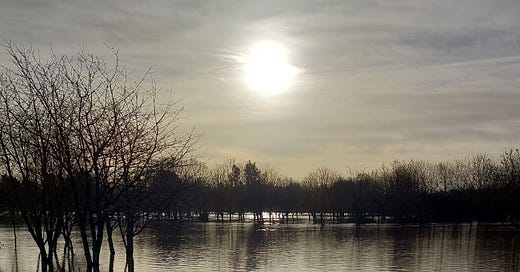Nature's Transformative Forces
After seeing the new year in with family, we returned home to a flood warning. The river near our house bursts its banks regularly, although its levels have reached yet another record high. But there are flood barriers in place, and floodplains that are doing exactly what they're designed to do.
The photo above shows the golf course we live next to. The river's usual course lies some distance beyond the line of trees. This is nature reminding us that, whenver she chooses, she can destroy everything people have built. We often think that we can control nature, but we have nothing to match her true power.
Of course, your fictional worlds are also subject to the power of nature, and the landscape is changed, formed, or destroyed by it. Whether over several centuries, or in mere moments.
A Quick Reference Guide
These are some of the ways in which your landscape might bear the marks of nature. And these changes can have big changes on the people living there. Nature can completely destroy communities, or it can create new refuges for them. It can force changes to traditional ways of life, or bring new opportunities and improvements.
Riverine Reshaping: Constant water flow gradually wears away rock and soil. Sediments carried downstream can create fertile floodplains.
Volcanic Dynamics: Molten lava spreads, cooling and solidifying to create new landforms. Different types of lava flows result in diverse landscapes.
Glacial Sculpting: Slow movement of glaciers wears down mountains and valleys.
Coastal Transformations: Coastal waves erode shorelines and cliffs. Sediment deposition creates beaches, sandbars, and barrier islands.
Sea Level Changes: Rising sea levels flood low-lying areas. Falling sea levels expose submerged landforms.
Tectonic Activity: Sudden movements along fault lines can uplift or lower the land. Subsidence or uplift alters the topography. Colliding tectonic plates create mountain ranges. Erosion shapes peaks and valleys over geological time.
Subterranean Forces: Dissolution of soluble rocks (e.g., limestone) creates caves. Stalactites and stalagmites form through mineral deposition. Dissolution of soluble rocks near the surface leads to sinkholes.
Meteorological Influences: Wind carries away loose soil particles, creating dunes. Rock features may be shaped by wind-blown sand. Repeated freezing and thawing of water in rock cracks causes fragmentation.
On Thursday, we'll be exploring the transformative power of nature in more depth.





